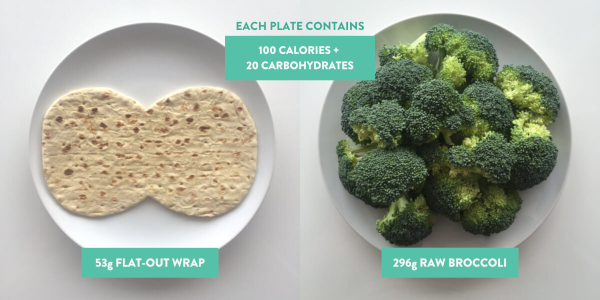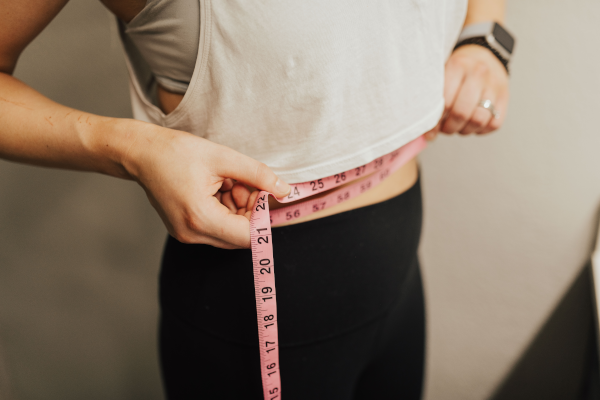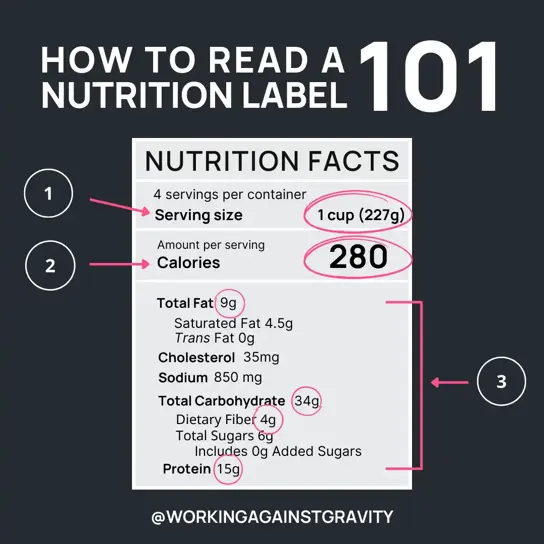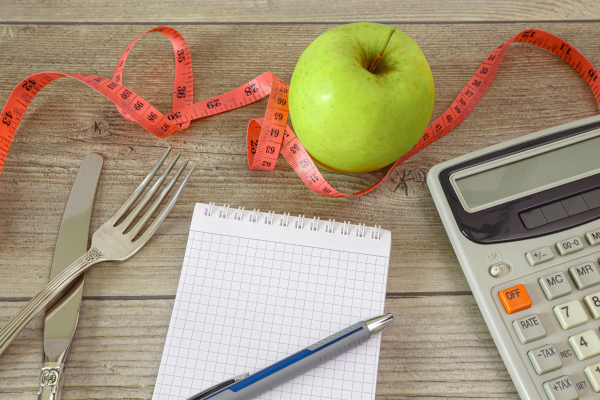Wondering how to count macros for weight loss? You're not alone if you have weight loss goals. Did you know that roughly 90% of people who lose substantial weight gain about half of it back [1]? This statistic highlights the importance of education and awareness when it comes to your food intake, habit-building, and how weight loss happens in the first place.
At WAG Nutrition Coaching, we've taught thousands of people how to count macros for weight loss. Through coaching over 30,000 people, we've found that macro counting and tracking is an effective way to learn what is in your food, find out what works for your body, lose weight, and keep weight off long-term.

Today, we're providing an in-depth look at how to count macros for weight loss. We’ll tackle why counting macros is an effective way to lose weight, suggestions for getting started if you’re new to counting macros, how to calculate macros for weight loss, how to lose weight without negatively impacting your performance or recovery, and how to think about macro tracking (or not macro tracking) long-term.
Advertisement
Macro Counting Terms to Know
Here are a few need-to-know terms in the macro counting world:
- Athlete: At WAG Nutrition (and in this article), we consider an athlete “anyone who exercises on purpose.”
- Calorie Deficit: Eating below maintenance calorie levels (usually with the goal of weight loss)
- Calorie Surplus: Eating above maintenance calorie levels (usually with the goal of muscle gain).
- Fat Loss/Cutting: Different from weight loss, this specifically refers to losing body fat to maintain muscle mass as much as possible.
- Flexible Dieting: A nutrition plan that focuses on inclusion instead of exclusion and allows you to eat the foods you love as long as they fit within your daily macro targets.
- Grams (g): A small unit of measurement used when putting food on a food scale and entering serving sizes in a food tracking app. There are 28g in one oz.
- Maintenance Macros/Calories: A calorie intake that matches your daily calorie output and helps you maintain weight.
- Macronutrients (Macros): Protein, Carbohydrates, and Fats are the three macronutrients. Each plays an important and different role in your body. The ratio of these macronutrients (or macros) will change depending on your body, goals, lifestyle, preferences, and training modality.
- Macro Counting: Also called “macro tracking,” this is the act of using a food tracking app (like MyFitnessPal or MacrosFirst) to record the macronutrients in your food and eat a specific amount of protein, carbs, and fats each day.
- Muscle Gain/Bulking: Eating in a calorie surplus to get stronger/put on muscle mass.
- Ounces (oz): A unit of measurement used when putting food on a food scale and entering serving sizes in a food tracking app.
- Self-Efficacy: One’s belief in their ability to succeed in specific situations and reach their goals.
Related: WAG Words: Macro Tracking & Nutrition Words to Know
What is Macro Counting (and How Can Macro Tracking Help You Lose Weight)?
Before we dig into how to count macros for weight loss, you need to learn what macro counting (or “macro tracking”) is.
Macro counting is tracking and recording the amount of protein, carbohydrates, and fats you eat daily.
Advertisement
Each macronutrient is made up of calories. So, counting macros is a more specific way of counting calories.

Macro counting is more specific and more effective in helping you reach your body composition and performance goals. Think about it like this: Calorie counting enables you to manipulate the number you see on the scale. Macro counting helps you manage what your body looks like.
Related: Calories vs. Macros: The Big Picture
Advertisement
The Three Macronutrients: Protein, Carbohydrates, and Fats
Now that you’re ready to try macro tracking let’s explore the roles of protein, carbohydrates, and fats in the body.
The Role of Protein in the Body
There are four calories per gram of protein.
Protein is made of a combination of 22 amino acids (both essential and nonessential) and makes up your muscles, skin, hair, nails, eyes, and internal organs. Your body can make nonessential amino acids, but you need to get essential amino acids from the foods you eat.
Protein can be categorized in many ways. WAG members and coaches find it helpful to organize it by leanness (how much fat there is in a set serving size).

Advertisement
(Do you prefer to eat vegan? HERE are some vegan-specific protein ideas!)
Protein is responsible for muscle growth, healing from illness, cell recovery, and more. Although important for everyone, athletes must consider the amount and quality of protein consumption to meet nutrient needs even more closely [2].
Related: Easy Ways to Add Protein to Your Day
The Role of Fats in the Body
There are nine calories per gram of fat.
Fats facilitate the transport and absorption of vitamins such as A, D, E, and K. Omega-3 fatty acids support joint health, digestion, brain function, and cardiovascular health [3]. Fats also help healthy hormone production.
Advertisement
Fats digest slowly, so they keep you fuller for longer and are an excellent long-term energy source for your body.

Related: Healthy Fats for Weight Loss
The Role of Carbohydrates in the Body
There are four calories per gram of carbohydrate.
Carbohydrates, or “carbs,” are a single sugar unit that provides short-term energy. They are your body’s first choice for fuel. Carbohydrates are stored and used in two places:
- Glycogen in your liver to maintain blood sugar
- In your muscles to fuel movement and exercise

Advertisement
You can categorize carbs in many ways, from food type (fruits, vegetables, grains, etc.) to density. Carb density refers to how many carbs are present in a gram of food. A denser carb source has more carbs per gram, and a less dense, or high-volume, carb source has fewer carbs per gram.
Here’s a picture of what we mean:

Need some quick ways to add carbs to your routine? Here ya go!
Note: Those following a Ketogenic Diet manipulate carbohydrate intake, and WAG Nutrition coaches are trained to support keto clients successfully. That being said, we’ve generally seen that those who want to optimize performance need to eat more carbs. The more active you are and the muscle you have, the more carbs you need to sustain your activity, recovery, and muscle mass.
Advertisement
Download the free WAG Nutrition Guide to learn the ins and outs of macronutrients, get meal ideas & more.
How Many Macros Do You Need To Lose Weight?
That is the million-dollar question, isn’t it? The answer is different for everyone.
A personalized nutrition program is your best bet to reach your weight loss goal. Because macros are made up of calories, the first step in determining your daily macro needs is your daily calorie needs. Then, all it takes is a bit of math.
Advertisement
What Impacts Your Calorie Needs?
There are many players in the “How many calories do I need per day” game. The significant factors are:
- Age
- Sex
- NEAT (non-exercise activity thermogenesis)
- Exercise frequency/intensity
- Metabolism
- Dieting history
- Regular medications
- Your goals
How to Calculate Your Calorie and Macro Needs
We’ll walk you through step-by-step directions right here. You’ll learn the following:
- How to determine your daily calorie needs
- How to calculate a calorie deficit so you can lose weight
- How to calculate protein macros
- How to calculate fat macros
- How to calculate carbohydrate macros
We recommend downloading the WAG Macro Calculator Cheat Sheet so you can do the math right along with the instructional article.
Related: Macros For Cutting
What About Counting Macros for Muscle Gain?
If you’ve gotten this far and wondered, what if I want to gain muscle, not lose weight? You can still use most of this info to your advantage.
Advertisement
The role of protein, carbs, and fats in your body doesn’t change! The WAG Calorie and Macro Calculation article and accompanying downloadable Macro Calculator Cheat Sheet will teach you how to determine macros for muscle gain.
Related: Macros For Bulking
Related: Macros for Muscle Gain
Related: How to Lose Fat and Gain Muscle at the Same Time

Advertisement
Weight Loss Expectations
Weight loss and fat loss are not the same—your overall weight is made up of everything in your body, from your bones, muscles, fat mass, and organs to the dinner you just ate and that big glass of water you drank.
So, when you set a weight loss goal, you likely want fat loss. This requires a change in the composition of your body. In other words, you want to lose fat while holding onto as much muscle as possible.
Now that you know what your weight loss goal means, the next step is to set realistic expectations for weight loss. This is one of the most important things to do as you begin your journey.
This helps you:
- Know what to expect on a weekly and monthly basis
- Adjust your plan when you’re not meeting those expectations
- Minimize frustration due to unrealistic expectations
As we dive into healthy rates of fat loss, it is essential to remember that these are general guidelines and change based on your plan adherence, gender, genetics/metabolism, training frequency, current weight, and more.
Advertisement
Related: How Long Does it Take to See Results Counting Macros?
How Much Weight Is Healthy to Lose?
An average weight loss of one to two pounds per week is a realistic expectation if you're in a moderate caloric deficit.
Men and anyone with more weight to lose are usually on the higher side of the range (or slightly over). On the flip side, women and lean individuals typically see slower rates of weight loss. As you become leaner, your rate of fat loss will decrease since you do not have as much fat to lose.
Although this number may seem low, a slow and steady fat loss rate is almost always more sustainable in the long run.
The lower physical stress on your body and the lower physiological stress with lifestyle changes are easier to maintain throughout the dieting process. This can also help you avoid regaining weight after completing your dieting phase.
Advertisement
Rapid weight loss does have its place (ex, athletes looking to make weight for a particular event). However, one to two pounds of fat loss per week is a reasonable expectation for the' average' person.
Remember that this rate assumes you are consistent with your macro tracking and other healthy lifestyle habits. This is not a realistic expectation if you’re overeating your macros, not getting enough sleep, not hydrating, and skipping gym sessions.
Related: The Top 6 Things Holding You Back from Losing Weight
How to Accurately Calculate Weight Loss
Knowing when and how to measure body weight and changes in body composition is critical to weight loss progress. This article will teach you how to take body measurements accurately.
Advertisement
Pros and Cons of Macro Counting for Weight Loss
It would be great if you could achieve your goal body composition without any adverse side effects. But that isn’t a reality for most people.
Your body loves to be at homeostasis. Eating at a calorie deficit and dropping weight almost always puts stress on your body, which can manifest in many different ways.
Let’s dig into some things you may experience while counting macros for weight loss. We’ll start with the pros.
Potential Pros of Losing Weight While Counting Macros
Some people may immediately notice improved quality of life as the weight comes off. People with more weight to lose (those starting at a higher body fat percentage) will see more pros than cons—at least at first.
Related: What it Takes to Get Lean
Advertisement
- Improved performance: If you’re newer to the gym or have been training at high body weight, you may notice improvements in performance as you lose weight. Bodyweight exercises like pull-ups, push-ups, sit-ups, air squats, jumping movements, and burpees may become easier to perform. As you lose weight, cardio activities like running will also feel easier (on your lungs and joints!).
- Improved health markers: If your doctor has recommended weight loss for health reasons, dropping a few lbs will likely improve health markers and decrease your risk of developing serious health risks associated with obesity, like cardiovascular disease, type 2 diabetes, osteoarthritis, and even some cancers [4].
- Improved body composition: As you decrease calories and focus on adequate protein intake and resistance training, you'll likely notice a leaner body composition.
- Improved confidence: When you begin taking charge of your health and nutrition, you’ll notice more confidence not only in your body but also in your food choices, habit-building, and self-efficacy (check back in with the Macro Counting Terms to Know section!). Improved confidence in one area of your life (like your health) can spill into other areas like your relationships, career, and more.
Potential Cons of Losing Weight While Counting Macros (and What to Do About it)
The leaner you are, the leaner you get, and the longer you’ve been in a caloric deficit, the more you’ll notice the adverse side effects of losing weight.
Here are a few negative side effects of weight loss to watch out for and some tips and tricks to minimize them.
1. Higher Hunger
This is likely the first thing you’ll notice when you begin eating in a deficit. A bit of hunger before meals is a standard, healthy body signal—It is also to be expected when you consume fewer calories than your body burns. But even though it’s normal, it isn’t fun.
What to Do About Higher Hunger:
- Focus on volume first! Eat higher volume and fiber foods.
- Avoid protein bars and other dense macro sources so you can replace those macros with foods that physically fill your stomach.
- Stay hydrated, but avoid drinking your macros. Protein shakes, soda, alcohol, and even drinks like kombucha will start to rack up the macros without giving you much fullness or, as we like to say, "bang for your macro buck."
- Experiment with meal timing. Play around with smaller meals more often or bigger meals less frequently. You may find that one works better for you.
- Identify your “hungry times” and schedule meals near those times.
Related: How to Feel Full, Dealing with Lower Macros & Nutrient Timing for Life
Advertisement
2. Irritability/Increased Stress
A prolonged period of low-calorie intake impacts your body’s ability to regulate one of your stress hormones, cortisol [5]. If little things “that don’t usually stress you out” start to add up or you find that you’re snapping at your partner or friends, this could be due to a lack of adequate calories.What to Do
What to do About Increased Stress: Identify a few things that help you unwind and relax. Go for a walk, journal, meditate, or call a friend or family member. The trick is finding what works best for you. Maybe meditation isn’t your thing, but a 20-minute yoga session helps you ground yourself. Play around with different options until you find a winner. Remember, self-care doesn’t have to feel good while you’re doing it. Find something you know benefits your mind and body long-term and commit to it.
Related: How to Manage Stress, How to Stop Stress Eating
3. Disrupted Sleep
Because of its impact on stress and sleep hormones, low calories can impact your body’s ability to get to sleep and stay asleep [6]. Whether hunger is keeping you up (or getting you up) or you generally find that you’re more restless, disruptive sleep can have an incredible impact on your quality of life.
What to Do About Disrupted Sleep:
Advertisement
- Push up your bedtime and increase the total time you spend in bed. This will increase the likelihood that you are asleep for more of that time.
- Create a bedtime routine to help your body wind down at the end of a long day.
- Check out these sleep tips to increase your sleep quality.
- If hunger is your issue, try eating a larger meal with healthy fats closer to bedtime.
4. Sex Hormone Dysregulation
Shifts in sex hormones may impact men, but hormone dysregulation resulting from a low-calorie intake is seen most commonly in women, and strict, chronic dieting can impact long-term reproductive health [7]. Whether or not childrearing is a dream of yours, hormone and reproductive health are imperative to the overall quality of life.
What to Do About Sex Hormone Dysregulation: Hormone health should be primarily handled by a doctor you trust. That being said, your best bet, if you notice changes in period regularity or sex drive after cutting calories, will likely be to increase your intake and work with a medical professional to find any underlying issues that could be at play.
Related: PSA: Periods are Important
5. Impacts on Training and Recovery
After hunger, this will likely be the first thing you notice going on post-calorie-cut. Whether it is a dip in motivation to get your butt to the gym, noticing more soreness, or losing that “second gear” in a workout, the changes to training and recovery can hit hard when you’re in a calorie deficit.
What to Do About Changes in Training and Recovery: Luckily, these changes are mostly temporary and will likely begin immediately when calories increase. But, feeling good in the gym, well, feels good! So, here are a few things to try so you can keep your performance and recovery as strong as possible:
- Stay on top of protein intake and follow a slow and steady resistance training plan.
- Stick to specific nutrition timing based on your workout schedule
- Dial in your pre-and post-workout nutrition
- Get clear on your goals. If your main priority is performance, a macro cut (or a deep macro cut) may not be the best plan for you right now. But, if fat loss is your primary goal, you need to be okay with the potential of some changes in performance and recovery — at least temporarily.
Need help getting clear on your goals? Download WAG’s free Goal Setting Worksheet and learn the best way to set goals you’ll achieve.
Advertisement
A Few More Tips to Handle Negative Side Effects of Dieting
There are a few things that may help you navigate the adverse side effects of dieting no matter what you’re experiencing:
Increase Calories
Setting clear goals and intentions is enormous here. Suppose the adverse side effects of losing weight impact your quality of life (your ability to socialize, train, hormone health, etc.). In that case, you need to be honest with yourself and determine if a break from your diet is warranted.
Especially if you’re already relatively lean, ask yourself if these trade-offs are worth the last few pounds. Increasing calories with a reverse diet or spending time at maintenance could be your best move.
Work With an Experienced Coach
We get it; it can be really tough to decide the “best way to lose weight” if you’re new to the process. Being an objective third party to your progress and process is also tough. An experienced nutrition coach can help you determine what hunger levels are “normal” if you’re optimizing your sleep habits, how to get the most out of your training while in a cut, and so much more. Offloading the stress and decision-making could be the thing standing between you and your dream body composition.
How to Count Your Macros
So far, we’ve covered the following:
Advertisement
- Macro counting terms you need to know
- What macro counting is and how it can help you lose weight
- The role protein, carbohydrates, and fats play in your body
- How to determine your starting calories and macros for weight loss
- What to expect when it comes to weight loss speed and timing
- The pros and cons of losing weight (and what to do about the adverse side effects)
You’re probably itching to get to the meat and potatoes of this whole thing: How to count your macros. There are two main steps (and a 3rd for WAG Members!) to tracking your macros:
- Learning to read a nutrition label
- Entering your goal macros and daily foods into your tracking app
- If you’re a WAGger — enter your information in your coaching app and share that info with your coach during your weekly check-in!
How to Read a Nutrition Label
Let’s peek at an example nutrition label (originally posted on our Instagram!) and break it down.

Here is what you’ll see on this example food label:
- SERVING SIZE: this is not a recommendation of how much to eat in one sitting! It just reflects the amount people usually eat or drink, OR it could reflect a specific calorie number so the packaging can claim “100 calories per serving”. But it’s important to note that the rest of the numbers on the food label refer to whatever serving size is listed.
- CALORIES: Total calories per serving, not for the entire container. You'll want to keep reading since we count macros, not just calories!
- NUTRIENTS: Protein, carbs, fats, and fiber are the most significant things to look at. High protein or fiber numbers are usually a YES, but there’s room for everything when you’re flexible dieting.
- % DAILY VALUE: This refers to how much a nutrient in your food contributes to a daily diet of 2,000 calories. We consider anything 5% or below “low” and 20% or above “high.”
Under a label, you’ll find a list of ingredients. It is worth taking a peek to ensure you’re eating foods and ingredients you’re comfortable with.
Advertisement
Although some processed foods here are generally no big deal in the grand scheme of your health, we still recommend opting for foods with shorter ingredient lists full of words you can pronounce and recognize.
Related: How to Read a Nutrition Label
How to Track Foods Without a Nutrition Label
Speaking of ingredient lists, what if you’re tracking a food without a nutrition label or ingredient list? How do you track a whole apple, an egg, or a homegrown tomato?
This is where getting to know your food-tracking app comes into play. You’ll need to use your app’s “Search” function to find a reliable, matching entry. Let’s chat about exactly how to use your app.
Entering Your Macro Goals & Foods In Tracking App
At WAG, we encourage our members to use MacrosFirst as their tracking app. We’ve found that it is the most reliable; it syncs directly with our coaching app, Seismic. We work with the founders to keep the entries up-to-date and suggest improvements or new features.
Advertisement
We have an entire YouTube playlist full of MacrosFirst tutorials. Check them out here!
Related: What is the Best Free Macro Tracking App?
Enter Your Goals into Your Tracking App
The first step is entering your goals in your tracking app. This allows you to keep tabs on how much you’ve eaten and how many more macros you need to hit your daily goals. Here’s how to do this in MacrosFirst.
The free version, MacrosFirst, lets you see your daily and remaining macros at the top of your food diary. WIN!
(P.S. You’d have to pay for this feature with MyFitnessPal — “MFP.”)
Advertisement
Enter Your Foods into Your Tracking App
Here’s how to enter the foods you eat into your tracking app:
If your food has a barcode:
- Scan the barcode of your food into your diary to pull up the nutrition information
- Double-check that the macros displayed in your app match what you see on the nutrition label (you may need to adjust the serving size in your app to match the label before you know for sure)
- Change the serving size in your app to match what you want/need to eat — use grams or ounces to be the most precise
- Serve yourself the correct amount of food — use a food scale to weigh your food in grams or ounces
- ENJOY!
Related: Macros, Calories, Grams, and Ounces: What are the Differences? and Should I Weight My Food Raw or Cooked?
If your food doesn’t have a barcode:
- Search for the food you’re eating using the “search” function. Make sure you choose the entry that matches your cooking method most closely. If you’re weighing a raw chicken breast, use an entry for “raw chicken breast.” If you’re weighing steamed broccoli, use an entry for “steamed broccoli.” If you’re weighing a hardboiled egg, use a “hardboiled egg” entry.
- You may see many entries like “medium apple.” Although this is great in a pinch, we recommend changing the entry and using “grams” or “ounces” for more precision.
- If you’re unsure about the accuracy of an entry you’ve found, double-check it with an external food database, such as CalorieKing or the USDA Database.
Here are a few more helpful tutorials that will make tracking foods in your app quick and easy:
Advertisement
- The Basics of Counting Macros
- Our Complete List of MacrosFirst Tutorials
- Still using MyFitnessPal? Here are some Standard and Premium tutorials to get you started!
- How to Log Meals in MacrosFirst
- How to Create Custom Foods
- How to Create a Recipe and Log a Single-Serving
- Should I Weigh My Food Before or After Cooking?
Tips & Tricks for How to Count Macros for Weight Loss
The physical act of tracking and weighing your food isn’t overly complicated.
But consistently hitting your macro targets by the end of the day takes some practice. It’s important to remember that it’s just like starting anything new and different. It takes time and effort before it feels natural.
Download our free Macro Calculator Cheat Sheet + 18 Tips and Tricks Bundle to get some of our favorites. Then, take a peek at these Habits of Highly Effective WAGgers.
Spoiler alert! It is all about meal prepping and planning ahead.
Advertisement
A Long-Term Look at Counting Macros for Weight Loss
“Do I have to count macros forever?” is a question we frequently get at WAG. Even when it has become second nature and feels effortless, tracking for the rest of your life probably isn’t in your goals—nor should it be!
We liken tracking macros to reading a textbook for school. It contains the down-and-dirty, detailed information you need to practice, write onto flashcards, and memorize. Then, you can apply that knowledge in the real world without having to open your textbook.
Precise macro tracking (your “textbook”) is always there to go back to if you need a refresher or your goals change. But, with time and practice, you can trust your knowledge and let go of the more strict approach. WAG coaches work on one of the biggest things with their clients is building confidence in portion sizes and listening to hunger cues so they can use these skills to step away from strict tracking and still feel confident in their choices and bodies.
That being said, it always comes down to your goals—letting go of precise tracking is typically best when:
- You’ve reached your body composition goal, and you’re okay with living within 5-10lbs of that weight/physique
- You’re going on a vacation
- You need a mental break
- You feel confident and comfortable estimating your intake and listening to accurate hunger cues
Because estimation and intentional eating are less precise, staying highly lean or maximizing muscle gain and performance without tracking is tougher. So, it’s always worth checking back in with your goals and remembering that you can use tracking strategically based on your season of life.
Advertisement
Related: Are Macros Forever?, Don’t Fear Life After Tracking & What it Takes to Get Lean
Tying It All Together
There you have it: an in-depth guide to how to count macros for weight loss.
We just gave you a LOT of information, and if you’re feeling a bit overwhelmed, we don’t blame you. That is what we’re here for. At WAG Nutrition, our experienced, AFAA, and NASM-approved coaches will not only help you reach your weight loss goal. But they’ll also help you learn what it takes to sustain your weight loss long-term without giving up the foods you love.
References:
- https://healthblog.uofmhealth.org/health-management/weighing-facts-tough-truth-about-weight-loss#:~:text=D.&text=Scientists%20have%20been%20working%20to,just%20about%20all%20of%20it.
- Martinez, J., Navas-Carretero, S., Saris, W., & Astrup, A. (2014). Personalized weight loss strategies-the role of macronutrient distribution. Nature Reviews Endocrinology, 10(12), 749–760. https://doi.org/10.1038/nrendo.2014.175
- National Center for Complementary and Integrative Health (2021, July 27). 7 things to know about omega-3 fatty acids. https://www.nccih.nih.gov/health/tips/things-to-know-about-omega-fatty-acids
- https://www.who.int/news-room/questions-and-answers/item/obesity-health-consequences-of-being-overweight#:~:text=Being%20overweight%20or%20obese%20can,endometrial%2C%20breast%20and%20colon).
- https://www.rwjf.org/en/library/research/2010/05/low-calorie-dieting-increases-cortisol.html#:~:text=A%20group%20of%20healthy%20women,their%20diets%2C%20experienced%20psychological%20stress.
- https://pubmed.ncbi.nlm.nih.gov/8310984/
- https://www.ncbi.nlm.nih.gov/pmc/articles/PMC2634963/








